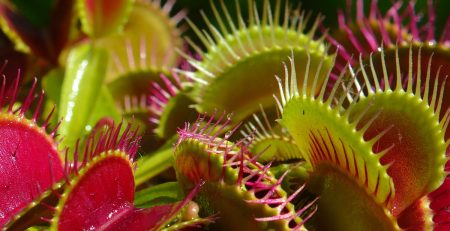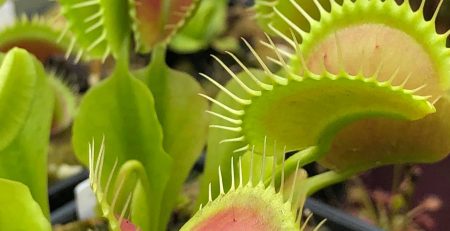Official VenusFlytrap.com Care Sheet, Part 1
Venus Flytrap care Sheet page 1
It is extremely important that the care sheet directions that come with your plant are strictly followed. If you have plans to grow your plant in a different way, or with a different soil or a different pot, or have read different care information online or in a book I strongly urge you not do this and to strictly follow the care sheet direction instead. I strongly recommend not using carnivorous plant soil purchased from a different seller. Potting: (you can also see how your plant should look when potted up on the back of the FAQ sheet) Use only the dried moss that came with your plant to pot it up with. This is the straw-like packing stuffer that was in your package.
If your order came with a white bag with a red line on it, this is a heat pack. Do not empty the contents of the heat pack and mix it in with your moss. Only the net pot that came with your order or a saucerless standard plastic pot. Self watering pots or pots with built in saucers will kill your Venus Fly Trap. Don’t take your Venus Flytrap (VFT) out of its baggie and keep it out of sunlight or heat until you have the correct type of water mentioned below and your moss is ready.
If you purchased 2 or more plants check if they are wrapped together. It is better that they are spaced apart when you plant them if they are going into the same pot as opposed to being planted together in one bundle. It’s best to plant all the plants that came with your order in the same pot they came with instead of putting them in other pots that may not be safe to use or have enough moss in them. To pot up your VFT, first put your long fibered sphagnum moss in a bowl with Reverse Osmosis or Distilled water. Make sure to loosen the fibers and mix it around in the bowl to help it hydrate. Then wrap the wet moss around your Venus Flytrap’s roots and around the rhizome (white bulb part the leaves are attached to that sometimes is pink).
This includes the part of the rhizome just underneath the leaves, even if they are prostrate or curled downwards. You may need to gently hold the leaves that the traps are attached to up to do this. The rhizome should be buried at the top of the pot and not exposed to light. Green or red leaves go above the moss, white or whitish yellow should be buried. Then fill up the rest of the pot with the remaining moss making sure that the rhizome is still buried just below the top of the pot. Put your Venus Flytrap’s net pot in a bowl or saucer that is at least 5 inches wide and no higher than the top of the pot. Fill up the bowl or saucer with Reverse Osmosis or Distilled water to about 1/4th the way up the pot.
Do not put anything else extra like, rocks, marbles, shells, etc, in the bowl or saucer your plant’s pot is sitting in or in the dish the pot sits in. Extra moss should not be placed in the VFT’s dish, either. If you have more than is needed to fill the VFT’s pot it can be redried and stored for later use. Only the net pot your VFT came with or a plastic 3 or 4 inch pot should be used to pot up your VFT initially. The plant should not be placed where it has air blowing on it or near it, like a fan or an A/C or heater vent. If you repot your VFT into a larger pot you should wait at least 2 months and you will need to use only long fibered sphagnum moss or peat that has no additives(like fertilizers) in it. Venus Flytraps should be grown in open air not in a terrarium, in a jar, or under a humidity dome. Clay or Terra Cotta pots or saucers or a different type of soil should never be used. If you are planning on growing your VFT outside you should grow it indoors next to a sunny window for 2 weeks first to acclimate it to outside growing.












Leave a Reply
You must be logged in to post a comment.